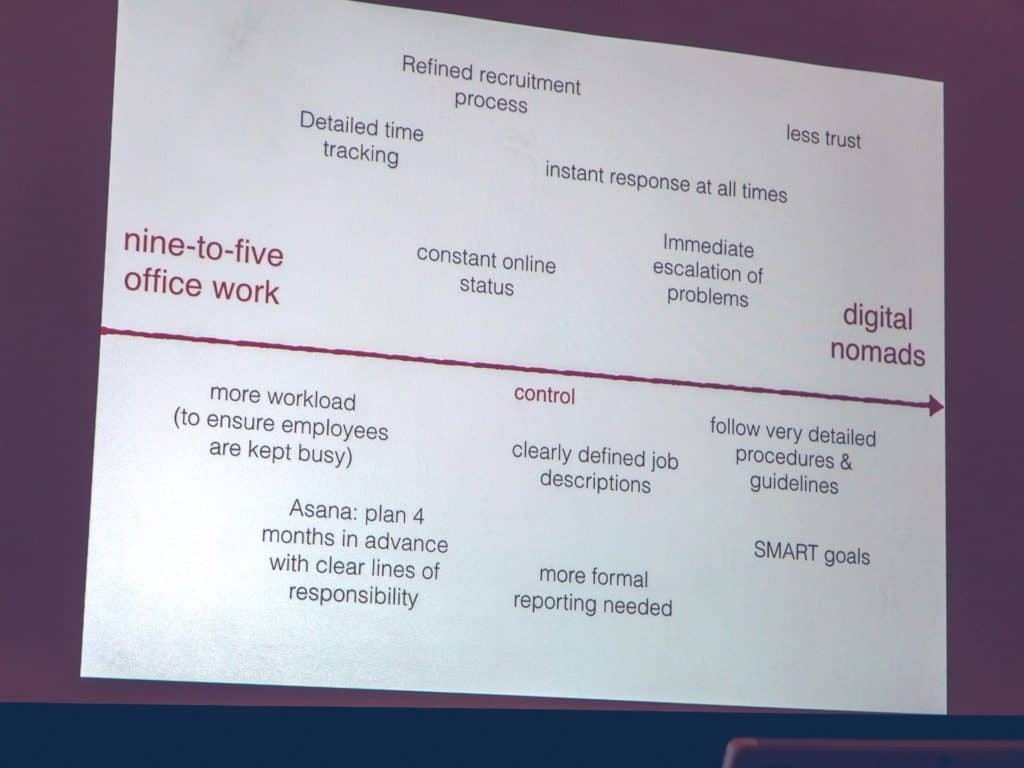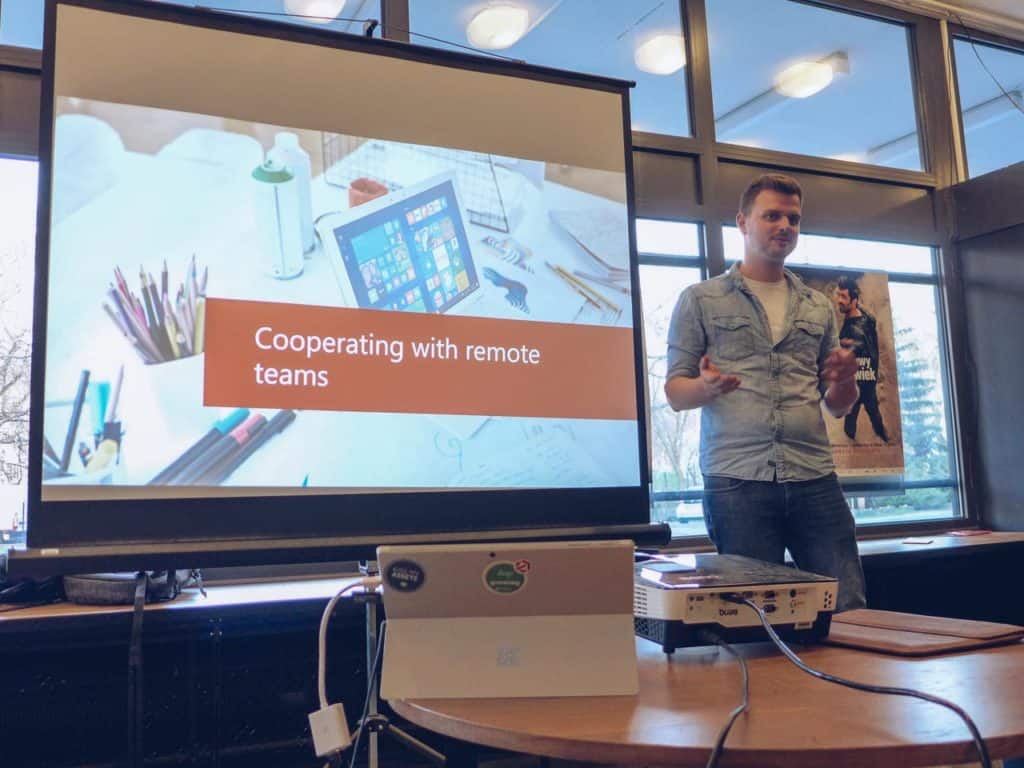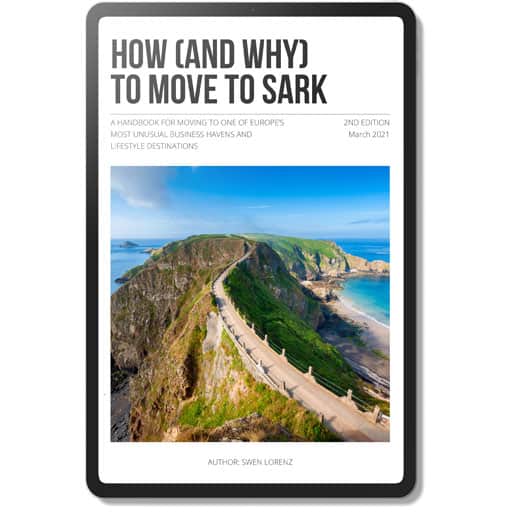Fixed work of the kind our parents viewed as normal is a very old concept. Managing companies and teams has entered a new, dynamic era that brings with it a shift in how to best engage employees, especially when it comes to top talent. If your company is still primarily focussed on paying its employees based on the amount of time they spend on a task and being placed in a specific place, rather than based on their output, then you are probably missing opportunities to perform better.
What precisely flexibility and freedom mean will vary with each case – but it very often comes down to remote working. Here are some examples of – successful – companies that have defined their own models for offering their employees a different way of working:
- Upwork: one day per week employees can work online from anywhere they wish.
- Dropbox: everyone gets one day per week without any meetings, so they can also work remotely that day if they like.
- Buffer: the entire company of 70 employees works remotely and has never had an office.
What is true for all of these cases is that managers face new challenges in setting up and managing such teams. Supervising a remote team is different from overseeing a team that sits together in an office.
I had managed remote teams myself, at the time mainly relying on my instinct and common sense, especially since I started doing this before it even became much of a public subject.
That’s why I enjoyed an event organised by Dagmara Kowalik and Thomas van den Broek, two project managers specialised in managing remote teams in the tech industry.
Hearing advice from experts with a proven track record in dealing with this challenge gave me both a deeper understanding of the general background and industry trends (which Dagmara focussed on), as well as a number of tools and insights that I will use to improve how I manage such teams in the future (the focus of Thomas’ presentation).
Here is a quick run-down of the key points you missed if you didn’t have a chance to attend the Reactor Meetup event in Warsaw a few months back.
This subject still divides opinion
As Dagmara put it, the entire subject of remote working “triggers a lot of discussions”, not the least because there are also negative examples. E.g., there was a lot of media attention when Yahoo’s high-profile CEO, Marissa Meyer, decided to call the company’s remote staff back into the office. There is a significant number of people to whom working remotely “has the connotation of doing nothing.”
Does such scepticism hold up to scrutiny?
Dig deeper into individual cases, and you’ll often find that negative examples were down to mistakes committed by the company when it comes to managing their human resources, rather than due to the concept of remote working itself.
E.g., in the case of Yahoo, it seems pretty obvious that recalling the remote workforce was (ab)used as a scapegoat by a board that had to be seen as doing something. What Yahoo probably should have done was to consider why the board members, who are ultimately responsible for a company’s longer-term performance, had allowed the company to get into such bad shape in the first place.

Dagmara Kowalik: “Define the exact needs of your business and then create a remote work concept that is tailored to your specific situation.”
There are a few undeniable truths that will lead to remote working not only becoming a permanent, but also a growing part of the way businesses operate:
- Market pressures and competition are forcing companies to ask themselves tough questions about their output and their cost structure. E.g., why shell out a lot of money for office space at a time when office rents in major cities are sky-high, instead of letting employees work from their home office.
- The millennial generation is entering the workforce, demanding a more dynamic setup because they see “their work environment as part of their home.”
- A growing number of (sometimes: wildly) successful companies are using flexible arrangements as part of their branding to attract the best talent.
Or as Melanie Collins from Dropbox put it: “Flexibility will become the norm for employers who want to win the war on talent.”
Communicate, communicate, communicate
Reporting, and the broader subject of communication, in general, is absolutely vital for remote working.
Thomas spoke about this in more detail, based on his experience of managing an overall team that includes 25 conventional employees spread between two offices, some employees contributing from co-working spaces, and yet another group of employees working remotely – which gives him team-managing experience from different angles.
“When you work remotely, you don’t communicate in the same way as when done in the office. Be very conscious about communication. Make your employees conscious of why they should communicate and how.”
“As a project manager, check in with people every day and ask them how they are doing.”
“Use tools to communicate. With public channels such as Slack, people are always in the loop. It is information overload, but it’s the only way to ensure everyone is always on the same page.”
“Be conscious how you use these tools, i.e., issue clear guidelines which tools to use and why. Stay informed how your tools work and re-evaluate them for every project.”

Thomas van den Broek sharing his experience in managing teams with a flexible, mixed setup.
There is also a need for a space where to physically meet when the situation calls for it: “Make sure there is a shared workspace. It is a must.”
How to form such a team? Thomas: “We first define what does the client want? Then we define who we have on the team and what we want from the team members. We also define what the definition of ‘done’ is. Build your remote team with a goal in mind.”
“You have to trust your remote workers. You cannot control them on a day-to-day basis.”
“How do you make people feel part of the team? Constant communication; events, i.e., have people get together; and weekly one-on-ones.”
“For the weekly discussions, ask them how they feel about being on the team, and make sure that they feel they matter.”
“People are key to success. You need to invest more time in your team than your client.”
“For the internal managing, writing is so important. 40% of our interview process is writing. People who cannot write will fail.”
“Ask yourself if it is all transparent enough.”
“Have a feedback process. How are your remote workers seeing the team structure and are they happy? If not, what are you going to do about it?”
“Establish consistency in how you manage meetings and reporting. This consistency will help to reduce complexity.”
“Over-communicate!”
Bringing it together
Smart people can increasingly pick their employer as they like. Here are some of the questions you should ask yourself:
- What are you offering to attract top people who require flexibility and freedom?
- Have you started to utilise your successful engagement of top talent as part of your company’s branding so that you can begin to automatically attract yet more top talent wanting to join you?
- Do you have the right managers and the right company culture to move towards this direction? E.g., some companies have massive disconnects such as an (often: younger) workforce that prefers to communicate by email but an (often: older) supervisor who isn’t good at communicating in writing and forces everyone into lengthy phone calls; something that will ultimately lead to talent loss.
There are no fixed answers that fit everyone. However, the evidence on the table in the form of case studies, the crowd this event in Warsaw attracted despite minimal publicity, and the quality discussions that were had well into the evening all show that it’s a subject that company owners, boards, CEOs and other managers should spend time thinking about. There may be some tough questions for them to ask themselves.
If you enjoyed this, you might also find the following articles useful:
Want to print this article? Open a printer friendly version.
Did you find this article useful and enjoyable? If you want to read my next articles right when they come out, please sign up to my email list.
Share this post:


